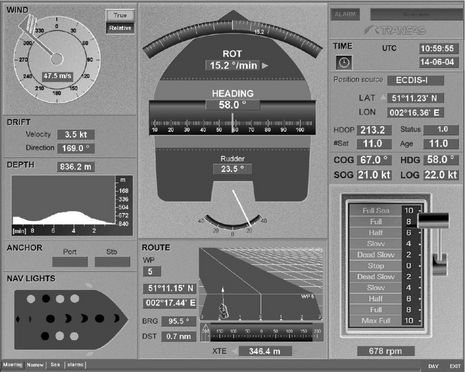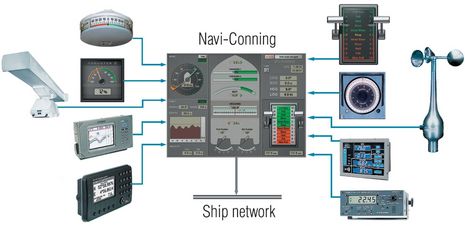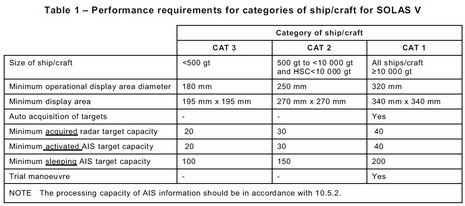Conning displays, another use for NMEA 2000
It wasn’t just pirate drama (hurray for the good guys!) that had me thinking about big ship helms recently. When I was reading IEC documents about AIS target plotting last week, I came across the nifty “conning display” above. Even in greyscale it suggests how useful it is to integrate lots of usually discrete vessel data onto one screen. While I’ve seen conning displays in the past, and thought that something similar could be useful on even medium size yachts, that thought is particularly intriquing because nowadays every bit of data on this screen could be delivered over a single NMEA 2000 backbone.
It’s even possible now to put nav light status on an N2K network, given Maretron’s Run Indicator Module, and similar from Albatross Controls (which now has a U.S. distributor). It’s ironic then that, in fact, the Transas Navi-Conning system which collected all that data above uses “NMEA (ver. 2.1/3.0/3.01)…realized via serial RS232-type and virtual ports.” Pity the poor installer who has to get all those NMEA 0183 inputs seen below to work properly! Big ship electronics change at a glacial pace, but the IEC did finally approve NMEA 2000 and one day a ship’s conning display will simply tee off its N2K network, I think. Is it nuts to think a similar screen might useful on a boat like the soon-to-be-mine Gizmo, especially for docking in tight quarters? And isn’t it quite possible as sensors get more accurate and MFDs get better at NMEA 2000? And I wonder whatever happened to NMEA’s “intelligent gateway” idea, which would encourage marine PC software developers to work with N2K?















HI Ben…
This is pretty much exactly what I am working on here, though instead of a proprietary software model like the above, I am keeping everything browser-based and platform-agnostic. And as much as I love plug-n-play N2K for the essential nav tools, most of the trivial sensors are a lot easier (and cheaper) to handle with a distributed data collection model.
The neat thing about all this is that the Conn appears anywhere…
Cheers,
Steve
Hey Panbo, when it comes to weather are there any rain gauges that are N2K compliant? I can only find wind, temp and barometer in the airmar and Maretron devices.
Davis doesn’t seem to have anyway to pump their weather stations in to the N2K either.
But, Steve… isn’t it true that most helm MFDs lack a browser, and therefore could not access your conning display? And who but you would find building your own “distributed data collection” system easier than N2K?
Patrick, I’ve never seen a rain gauge on a boat. Have you?
I have a rain Gage on my Boat. It’s my port aft air tank, with the leaky cover. Rather than digital or analog, it is “dialog”, involving an audio signal from the tank like “gurgle” or “slosh” and a responding epithet from me. It’s extremely accurate, catching every drop of rain on the port quarter of my cat, but measures it all in an unusual increment: bbls/qtr, or “barrels of water since the last time I pumped it out, probably 3 months ago.”
I can ensure its accuracy by refraining from washing the boat or sailing in less than benign conditions.
Quoth Ben:
But, Steve… isn’t it true that most helm MFDs lack a browser, and therefore could not access your conning display? And who but you would find building your own “distributed data collection” system easier than N2K?
That’s actually one of my main complaints about the MFD industry… all that horsepower locked into a closed architecture. Of course, there is also the very appealing turn-key simplicity of something that “just works,” and I find that I really like both: a basic appliance chartplotter and a more general purpose system with sunlight-readable display. The latter then opens up all sorts of possibilities, including access to documentation, email, databases, being able to copy-paste between reference and nav tools, and of course my own apps.
As to the distributed data collection, the “business model” associated with my current project is to make all that stuff available (books and kits) for those who enjoy a bit of geeky DIY. It is not mutually exclusive with N2K, of course; I’m a huge Maretron fan and am happy with the current installation of nav goodies. It’s just all that other stuff that I want to incorporate into the same overarching system…
Cheers,
Steve